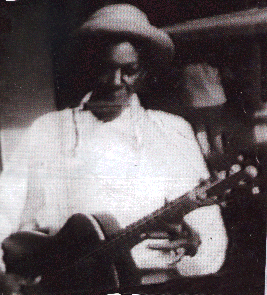One of the loveliest passages at the end of Bob Dylan's Chronicles Vol. 1 concerns the author's first discovery of the recordings of Robert Johnson. The ghost of Johnson has apparently haunted Mr. Dylan ever since -- enough to skew his better judgment.
More than thirty years later, I would see Johnson for myself in 8 seconds' worth of 8-milimeter film shot in Ruleville, Missisippi, on a brightly lit afternoon street by some Germans in the late 30s. Some people questioned whether it was really him, but slowing the eight seconds down so it was more like 80 seconds, you can see it really is Robert Johnson, has to be -- couldn't be anyone else. He's playing with huge, spiderlike hands and they magically move on the strings of his guitar. There's a harp rack with a harmonica around his neck. He looks nothing like a man of stone, no high-string temperament. He looks almost childlike, an angelic looking figure, innocent as can be. He's wearing a white linen jumper, coveralls and an unusual gilded cap like Little Lord Fauntleroy. He looks nothing like a man with a hellhound on his trail. He looks immune to human dread and you stare at the image in disbelief.Disbelief indeed. In fact the film footage described has been convincingly debunked. After much controversy it was finally noted that a movie theater in the background was showing the 1941 picture Blues In The Night. The film was shown in Ruleville on January 30, 1942. Robert Johnson died in 1938.

A still of the musician Mr. Dylan so lovingly describes. No one has the slightest idea who he is.
I was pondering this problem when I noticed the interesting wording of Mr. Dylan's last-quoted sentence, in particular his "disbelief." What disbelief? Disbelief in the bluesman's death? There is a fishy certificate acknowledging a dead Johnson but witnesses are scarce and highly untrustworthy. Or perhaps Mr. Dylan wants to disbelieve in something larger, Webermanian -- a disbelief in the debunkers' world, where Robert Johnson can be proven to be dead and no longer haunting the entryways of small Mississippi businesses. Who knows? Bob Dylan probably has access to a lot of things we don't know. Two last curious facts: First, the film Blues in the Night was an early quiet critique of white co-option of black musical tradition (a phenomenon of which Johnson has become the central icon). Second: Chronicles was published at least two years after the footage was "proved" non-Johnsonian.
DON'T BELIEVE WHAT YOU SEE. This widely-circulating image, purporting to depict Mesler and Rogel outside the old pruesspress studios, at the time they were recording Neighborhood Bully, has also been recently debunked.
